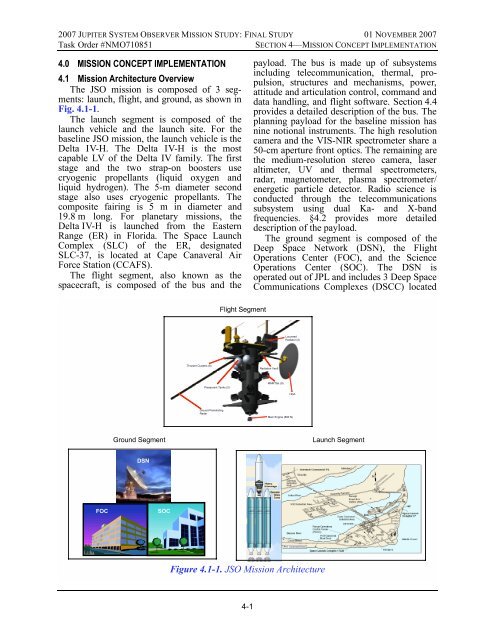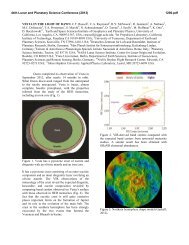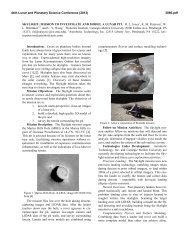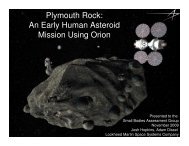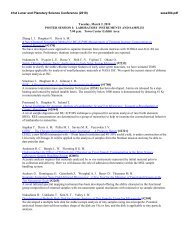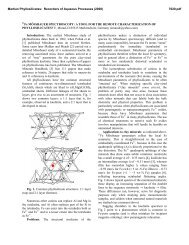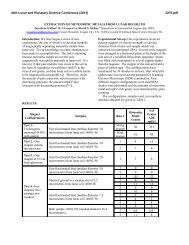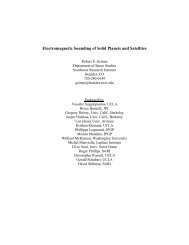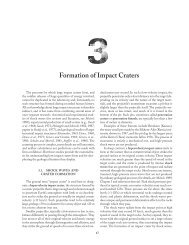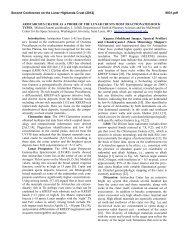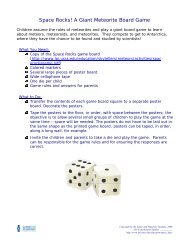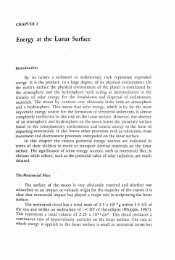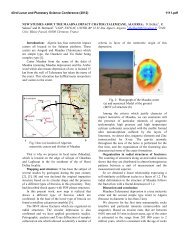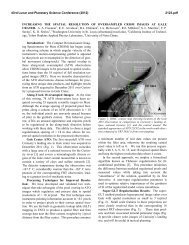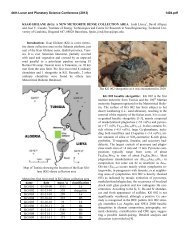Jupiter System Observer Mission Study: Final Report - Lunar and ...
Jupiter System Observer Mission Study: Final Report - Lunar and ...
Jupiter System Observer Mission Study: Final Report - Lunar and ...
You also want an ePaper? Increase the reach of your titles
YUMPU automatically turns print PDFs into web optimized ePapers that Google loves.
2007 JUPITER SYSTEM OBSERVER MISSION STUDY: FINAL STUDY 01 NOVEMBER 2007<br />
Task Order #NMO710851 SECTION 4—MISSION CONCEPT IMPLEMENTATION<br />
4.0 MISSION CONCEPT IMPLEMENTATION<br />
4.1 <strong>Mission</strong> Architecture Overview<br />
The JSO mission is composed of 3 segments:<br />
launch, flight, <strong>and</strong> ground, as shown in<br />
Fig. 4.1-1.<br />
The launch segment is composed of the<br />
launch vehicle <strong>and</strong> the launch site. For the<br />
baseline JSO mission, the launch vehicle is the<br />
Delta IV-H. The Delta IV-H is the most<br />
capable LV of the Delta IV family. The first<br />
stage <strong>and</strong> the two strap-on boosters use<br />
cryogenic propellants (liquid oxygen <strong>and</strong><br />
liquid hydrogen). The 5-m diameter second<br />
stage also uses cryogenic propellants. The<br />
composite fairing is 5 m in diameter <strong>and</strong><br />
19.8 m long. For planetary missions, the<br />
Delta IV-H is launched from the Eastern<br />
Range (ER) in Florida. The Space Launch<br />
Complex (SLC) of the ER, designated<br />
SLC-37, is located at Cape Canaveral Air<br />
Force Station (CCAFS).<br />
The flight segment, also known as the<br />
spacecraft, is composed of the bus <strong>and</strong> the<br />
Thruster Clusters (8)<br />
Pressurant Tanks (3)<br />
Ground Penetrating<br />
Radar<br />
Flight Segment<br />
4-1<br />
payload. The bus is made up of subsystems<br />
including telecommunication, thermal, propulsion,<br />
structures <strong>and</strong> mechanisms, power,<br />
attitude <strong>and</strong> articulation control, comm<strong>and</strong> <strong>and</strong><br />
data h<strong>and</strong>ling, <strong>and</strong> flight software. Section 4.4<br />
provides a detailed description of the bus. The<br />
planning payload for the baseline mission has<br />
nine notional instruments. The high resolution<br />
camera <strong>and</strong> the VIS-NIR spectrometer share a<br />
50-cm aperture front optics. The remaining are<br />
the medium-resolution stereo camera, laser<br />
altimeter, UV <strong>and</strong> thermal spectrometers,<br />
radar, magnetometer, plasma spectrometer/<br />
energetic particle detector. Radio science is<br />
conducted through the telecommunications<br />
subsystem using dual Ka- <strong>and</strong> X-b<strong>and</strong><br />
frequencies. §4.2 provides more detailed<br />
description of the payload.<br />
The ground segment is composed of the<br />
Deep Space Network (DSN), the Flight<br />
Operations Center (FOC), <strong>and</strong> the Science<br />
Operations Center (SOC). The DSN is<br />
operated out of JPL <strong>and</strong> includes 3 Deep Space<br />
Communications Complexes (DSCC) located<br />
Radiation Vault<br />
MMRTGs (8)<br />
Louvered<br />
Radiator (2)<br />
HGA<br />
Main Engine (890 N)<br />
Ground Segment Launch Segment<br />
DSN<br />
FOC SOC<br />
Figure 4.1-1. JSO <strong>Mission</strong> Architecture


